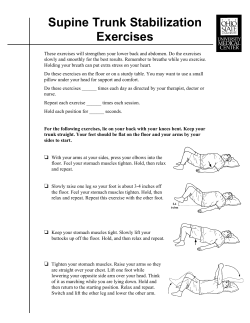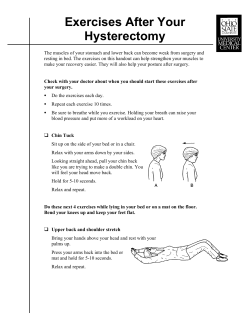
Herniated Disc: Exercises Your Kaiser Permanente Care Instructions
Herniated Disc: Exercises Your Kaiser Permanente Care Instructions Here are some examples of typical rehabilitation exercises for your condition. Start each exercise slowly. Ease off the exercise if you start to have pain. Your doctor or physical therapist will tell you when you can start these exercises and which ones will work best for you. How to do the exercises Note: These exercises can help you move easier and feel better. But when you first start doing them, you may have more pain in your back. This is normal, but it is important to pay close attention to your pain during and after each exercise. • Keep doing these exercises if your pain stays the same or moves from your leg and buttock more toward the middle of your spine. Pain moving out of your leg and buttock is a good sign. • Stop doing these exercises if your pain gets worse in your leg and buttock, or if you start to have pain in your leg and buttock that you didn't have before. Be sure to do these exercises in the order they appear and note how your pain changes before you move to the next one. If your pain is much worse right after exercise and remains worse the next day, do not do any of these exercises. Herniated Disc: Exercises (page 2) 1. Rest on belly 1. Lie on your stomach, face down, with your head turned to the side and your arms beside your body. If this bothers your neck, place your hands, one on top of the other, underneath your forehead to support your head and neck. 2. Try to relax your lower back muscles as much as you can. 3. Continue to lie on your stomach for 2 minutes. 4. If your pain spreads down your leg or increases down your leg, stop this exercise and do not do the next exercises. 2. Press-up 1. Lie on your stomach, face down, with your elbows tucked into your sides and under your shoulders. 2. Press your elbows down into the floor to raise your upper back. As you do this, relax your stomach muscles and allow your back to arch without using your back muscles. Let your low back relax completely as you arch up. Herniated Disc: Exercises (page 3) 3. Hold this position for 2 minutes. 4. Repeat 2 to 4 times. 5. If your pain spreads down your leg or increases down your leg, stop this exercise and do not do the next exercises. 3. Full press-up 1. Lie on your stomach, face down, with your elbows tucked into your sides and under your shoulders. 2. Straighten your elbows, and push your upper body up as far as you can. Allow your lower back to sag, and keep your hips, pelvis, and legs relaxed. 3. Hold this position for 5 seconds, and then relax. 4. Repeat 10 times, trying each time to raise your upper body a little higher and holding your arms a bit straighter each time. 5. If your pain spreads down your leg or increases down your leg, stop this exercise and do not move to the next exercise. 6. If you cannot do this exercise, you may instead try the backward bend exercise that follows. Herniated Disc: Exercises (page 4) 4. Backward bend • Stand with your feet hip-width apart, toes pointing forward. Do not lock your knees. • Place your hands in the small of your back. • Bend backward as far as you can, keeping your knees straight. Hold this position for 2 to 3 seconds, and then return to your starting position. • Repeat 2 to 4 times, trying each time to bend backward a little farther, until you bend backward as far as you can. • If your pain spreads down your leg or increases down your leg, stop this exercise. Follow-up care is a key part of your treatment and safety. Be sure to make and go to all appointments, and call your doctor if you are having problems. It's also a good idea to know your test results and keep a list of the medicines you take. Where can you learn more? Go to http://www.kp.org Enter Z594 in the search box to learn more about "Herniated Disc: Exercises". © 2006-2010 Healthwise, Incorporated. Care instructions adapted under license by Kaiser Permanente. This care instruction is for use with your licensed healthcare professional. If you have questions about a medical condition or this instruction, always ask your healthcare professional. Healthwise disclaims any warranty or liability for your use of this information.
© Copyright 2025
















![HOME TREATMENT OF BPPV: BRANDT-DAROFF EXERCISES [ ]](http://cdn1.abcdocz.com/store/data/000138030_1-95f56718c005f701249a339b29c2db3c-250x500.png)




